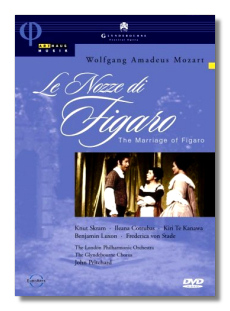
The Internet's Premier Classical Music Source
Related Links
- Mozart Reviews
- Latest Reviews
- More Reviews
-
By Composer
-
Collections
DVD & Blu-ray
Books
Concert Reviews
Articles/Interviews
Software
Audio
Search Amazon
Recommended Links
Site News
 DVD Review
DVD Review
Wolfgang Mozart

Le Nozze di Figaro
- Figaro – Knut Skram
- Susanna – Ileana Cotrubas
- Countess – Kiri Te Kanawa
- Count Almaviva – Benjamin Luxon
- Cherubino – Frederica von Stade
- Bartolo – Marius Rintzler
- Marcellina – Nucci Condo
The Glyndebourne Chorus
London Philharmonic Orchestra/John Pritchard
Stage Production – Peter Hall
Arthaus Musik DVD 101089 185min LPCM Stereo Full Screen
This classic production, originally broadcast from the Glyndebourne Festival in 1973, captures several favorite singers in their early prime. We look at Te Kanawa, Von Stade, and Luxon and think, "My God, how young they look!" Moreover, how wonderful they sound, and how appropriate they are for this opera, which suffers when it is performed by singers who are too mature. (After all, the Count and Countess are still young adults, not far removed from the time of The Barber of Seville.)
Director Peter Hall and designer John Bury accomplished wonders with the little Glyndebourne stage, particularly in Act Four, where the Count's gardens have seldom been so realistic. This is an intimate Figaro, as well it should be, because this opera is essentially intimate in nature. Hall does nothing controversial or self-indulgent here, and Beaumarchais, da Ponte, and Mozart are allowed to speak with the clarity that is their due.
It would be hard to improve upon the acting in this production. Some viewers might prefer a cooler and more restrained Countess – and indeed, it is made pretty clear that at least on one level, she is titillated by Cherubino's affection, and returns it – but it's also obvious that she sees herself as Susanna's mistress only by a trick of fate. This is in contrast with Luxon's Count, who relishes his perceived superiority over his underlings. Von Stade's Cherubino is endearingly boyish, and Cotrubas's Susanna is sharp without being arch. In the title role, Knut Skram is again refreshingly youthful and athletic. His singing is less distinctive than that of the other leads, but in a production in which the ensemble is strongly emphasized, Skram's relative lack of vocal distinction is really not a problem. Even the smaller roles are excellently cast. Hall reminds us that there are no bit parts, only bit actors. Granted, fans of the individual singers will want this DVD, but they will be disappointed if they are hoping that their diva will walk away with the evening. Pritchard's conducting is small-scaled and knowledgeable.
The picture (4:3 format) and sound (PCM Stereo) show their age a little, but not much. The nice thing about the sound is that it captures the theater's ambience – it's almost like being at Glyndebourne in the best seat. The subtitles are in English, French, German and Spanish – the English subtitles (at least) are a little sparse, but they are certainly adequate. No bonus features, but there should be no complaints when a three-hour opera fits onto a single DVD. The booklet includes an excellent essay by Babette Hesse. On the DVD itself, there are 87 (!) separate chapters for the opera, to facilitate access just about anywhere.
This will be a first-choice Figaro for almost everyone, except for those who demand the most refined sound, or a more self-consciously grand production.
Copyright © 2004, Raymond Tuttle



















